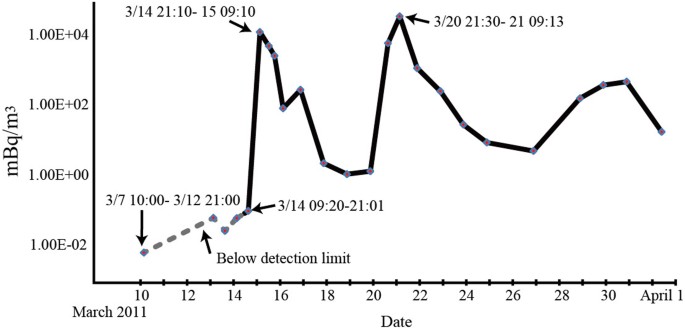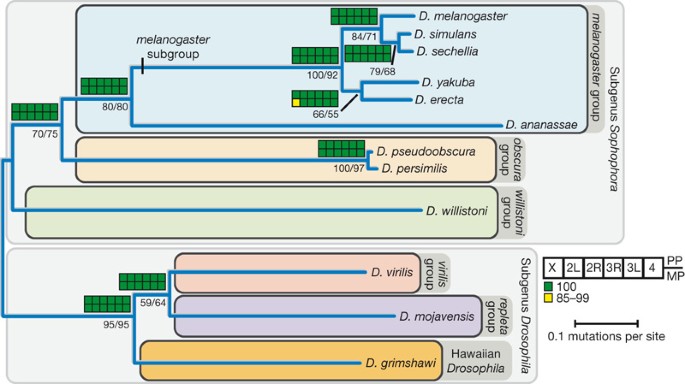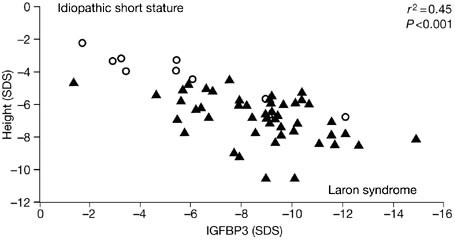
- Select a language for the TTS:
- UK English Female
- UK English Male
- US English Female
- US English Male
- Australian Female
- Australian Male
- Language selected: (auto detect) - EN
Play all audios:
ABSTRACT The Fukushima nuclear accident released radioactive materials into the environment over the entire Northern Hemisphere in March 2011 and the Japanese government is spending large
amounts of money to clean up the contaminated residential areas and agricultural fields. However, we still do not know the exact physical and chemical properties of the radioactive
materials. This study directly observed spherical Cs-bearing particles emitted during a relatively early stage (March 14–15) of the accident. In contrast to the Cs-bearing radioactive
materials that are currently assumed, these particles are larger, contain Fe, Zn and Cs and are water insoluble. Our simulation indicates that the spherical Cs-bearing particles mainly fell
onto the ground by dry deposition. The finding of the spherical Cs particles will be a key to understand the processes of the accident and to accurately evaluate the health impacts and the
residence time in the environment. SIMILAR CONTENT BEING VIEWED BY OTHERS CHARACTERIZATION OF TWO TYPES OF CESIUM-BEARING MICROPARTICLES EMITTED FROM THE FUKUSHIMA ACCIDENT VIA MULTIPLE
SYNCHROTRON RADIATION ANALYSES Article Open access 21 July 2020 RADIOCESIUM-BEARING MICROPARTICLES FOUND IN DRY DEPOSITION FALLOUT SAMPLES IMMEDIATELY AFTER THE FUKUSHIMA NUCLEAR ACCIDENT IN
THE KANTO REGION, JAPAN Article Open access 09 December 2023 TEMPORAL VARIATIONS OF 90SR AND 137CS IN ATMOSPHERIC DEPOSITIONS AFTER THE FUKUSHIMA DAIICHI NUCLEAR POWER PLANT ACCIDENT WITH
LONG-TERM OBSERVATIONS Article Open access 10 December 2020 INTRODUCTION An earthquake with a magnitude of 9.0 occurred in Japan on March 11, 2011. In addition to the earthquake itself, a
tsunami struck along the east coast of Honshu and damaged the Fukushima Daiichi nuclear power plant (FNPP). The FNPP eventually lost its ability to cool the nuclear fuel, which caused
hydrogen explosions and released radioactive materials into the environment1,2. Because of the local contamination, many people still cannot return home. Currently, the Japanese government
is spending considerable amounts of money to clean up the contaminated residential environment and agricultural fields. The radioactive materials released to the atmosphere traveled over the
entire Northern Hemisphere3,4,5,6,7. In Europe, for example, Masson et al.3 measured increases in radioactive cesium and iodine in the air from March 19, 2011 and showed that the maximum
levels occurred between March 28 and 30. Although the accident has global impacts, we still do not know exactly what happened in the reactors during the accident and the estimates of the
radioactive Cs releases vary largely from 9 to 36 PBq6,8,9,10. The chemical and physical properties (i.e., chemical forms, particle sizes, shape, phases (gas or aerosol), water solubility
and residence time) of the radioactive materials released into the environment are not well known11. Such knowledge is necessary to improve the numerical models to estimate the geographical
distributions and evaluate the human exposures during and after the accident. Because the mass of released radioactive material was small, i.e., the release of 137Cs from the accident was
<20 kg and the material spread globally, it is extremely difficult to chemically detect it other than by radioactivity detectors. In this study, we chemically detected Cs within single
particles for the first time by using electron microscopy and report the shape, composition, water solubility and sizes of the particles to evaluate the implications of their formation
process, occurrences in the environment and potential health effects. This knowledge is still important for preventing further accidents, finding effective ways to remove the radioactive
materials from the environment and preventing further resuspention of the materials. RESULTS TWO PLUME EVENTS The major radioactive material release events occurred during March 12 and 23,
2011 at the FNPP5. We collected aerosol samples on quartz fiber filters (25 cm × 20 cm) at the Meteorological Research Institute, Tsukuba, Japan, which is located 170 km southwest of FNPP
(see the Method section). In these samples, we found two significant peaks in the radioactivity concentrations between March 14 and 15 (Plume 1) and between March 20 and 22 (Plume 2) (Fig.
1). These significant plumes in the air were also reported in eastern Japan and polluted the water and soil2,12,13,14,15. Meteorological conditions, such as rain and the wind direction and
the releases of radioactive materials were the main causes of the high surface deposition events14. We used the filters that had the maximum radioactivity levels from each plume (from March
14, 21:10 (local time) to March 15, 09:10 and from March 20, 21:30 to March 21, 09:13) and analyzed portions of these filters (~10 cm2 per filter) using an imaging plate (IP) and a scanning
electron microscope (SEM) to directly observe the radioactive materials. In addition, we measured the aerosol particle size distributions within the plumes (Figs. S1 and S2). FIRST PLUME
(MARCH 14–15) We measured the radioactive materials that were collected in the filter at ground level on March 14–15 using the IP (Fig. 2). The radioactive materials were distributed spotty,
suggesting that the number of radioactive particles was relatively small but that their activity levels were relatively strong. Within this filter sample, we counted approximately 100 spots
caused by radioactive materials, suggesting a concentration of approximately 10 radioactive particles per m3. For reference, the average particle number concentration was 4.1 × 107 per m3
for particles larger than 0.5 μm from March 15 (Fig. S1). The spotty distribution in the IP image was also observed in the rooftop filter sample from March 15 (Fig. S3). To detect
radioactive particles using SEM, it is necessary to reduce the number of non-radioactive particles on the filter. Therefore, we cut the filter into many small parts to include the
radioactive spots features (Fig. S4). We then measured the radioactivity of each segment using IP and/or a Ge detector to chase the radioactive particle. After reducing the particle numbers
in the segments from the three radioactive spots, we used the SEM and found three radioactive Cs-bearing particles. In Figure 3, we show a particle containing Cs (Cs Particle 1). The
particle is spherical with a diameter of 2.6 μm. The energy dispersive X-ray spectrometer (EDS) spectrum shows Cs peaks. The Cs distribution in the elemental mapping image indicates that the
spherical particles consist of Cs along with substantial amounts of Fe and Zn and minor amounts of Cl, Mn and O. The decay-corrected activity (as of March 2011) of Cs Particle 1 is 3.27 ±
0.04 and 3.31 ± 0.06 Bq for 137Cs and 134Cs, respectively (Fig. S5). Assuming a particle density of 2.0 g/cm3, the Cs mass percentage within the particle is estimated from its activity (Bq)
to be 5.5. Another Cs-bearing particles (Cs particles 2 and 3) from the same filter but different spots are similar to Cs Particle 1, although they have weaker activity (Fig. S6). The
particles consist of Fe, Zn and Cs and are approximately 2.0 μm in diameter. The radioactivity for Cs particle 2 is 0.66 ± 0.02 and 0.78 ± 0.04 Bq for 137Cs and 134Cs, respectively. The Cs
mass percentage within Particle 2 is estimated from its activity to be 2.5. Assuming that the entire the radioactivity in the Plume 1 was from the Cs-bearing spherical particles gives an
average of 1.4 Bq per particle, which is comparable to that of Particle 2. We analyzed the water solubility of Cs Particle 1 by comparing the particle's shape before and after exposure
to water (Fig. S7). The results show that there was no change in shape, suggesting that the particle was insoluble to water at least during atmospheric transportation. SECOND PLUME (MARCH
20–21) The IP image of the filter collected on March 20–21 indicates that the radioactive materials are evenly distributed within the filter with approximately 10 diffused spots (Fig. 2). We
cut the filter including a diffused spot, formed several layers and captured the IP image (Fig. S8). The radioactivity is distributed along the filter segments, a result which differs from
that of Plume 1. We interpret that small amounts of the radioactive Cs attach to other dominant aerosol particles and that the occurrence is consistent with the results of Kaneyasu et al.16
about the role of sulfate aerosols as carriers of 137Cs. An SEM analysis with EDS elemental mapping shows numerous sulfate and mineral dust, as is commonly found in aerosol samples (Fig.
S8). The aerosol filter sample from the rooftop site also indicates a similar distribution of radioactive materials (Fig. S3). MODEL We simulated the depositions of the radioactive particles
from Plumes 1 and 2 using a tagged chemical transport model. Unlike other simulation models (e.g.4,6,9,12), we considered the aerosol dynamical processes explicitly and used the measured
values and assumptions of the particle physical and chemical properties from our observations, i.e., on March 14–15, radioactive Cs consisted of 2.3 μm hydrophobic particles, whereas on
March 20–21, the Cs was carried by hydrophilic submicron particles (e.g., sulfate). The tagged simulation result indicates that the aerosol particles on the filter sample from Plume 1 were
mainly emitted during March 14, 17:00 to March 15, 02:00 (JST) from the FNPP. On the other hand, the aerosol particles on the filter sample from Plume 2 were mainly emitted during March 19,
20:00 and March 20, 07:00. In Figure 4, we show simulation of the total (dry + wet) 137Cs deposition. Within Plume 1, 17% and 5.1 × 10−3% of the 137Cs released from the FNPP fell onto the
ground by dry and wet deposition processes, respectively and the rest (83%) was deposited into the ocean or was transported out of the model domain. In contrast, the deposition ratios onto
the ground for the particles within Plume 2 were 1.9% and 3.8% by dry and wet deposition, respectively. DISCUSSION This study reports for the first time the presence of spherical radioactive
Cs-bearing particles emitted from the FNPP during a relatively early stage (March 14–15) of the accident. The particles coexist with Fe, Zn and possibly other elements and their diameters
are approximately 2 μm. Because these elements were evenly distributed within the particle, we conclude that they are internally mixed and form an alloy. This result differs from that
reported by Kaneyasu et al.16, who showed that the Cs measured on samples collected during April and May 2011 was carried by sulfate aerosol particles approximately 0.5 μm in size. Due to
its spherical shape and composition, the particle is likely solid and is largely insoluble in water. Spherical aerosol particles, such as fly ash, commonly form from liquidized materials or
during the condensation of vaporized materials depending on their sizes17. The spherical Cs-bearing particles were larger and less water soluble than sulfate particles, resulting in more dry
deposition and less deposition in the region northwest of the FNPP (Figs. 4 and S9). If we assume that all of the Cs had been carried by the sulfate aerosol particles in Plume 1, 5.6% and
9.3% of the released 137Cs should have been deposited through dry and wet deposition processes, respectively. Accordingly, the geographical distribution of Cs deposition differs depending on
the physical and chemical properties (Fig. S9), although the quantitative radioactivity levels for the total deposition in the model depend on assumptions such as cloud microphysics and the
total amount of emissions from the FNPP, which is still under debate. Our model results suggest that because the dry and wet deposition processes are sensitive to the chemical form and
sizes of the Cs carriers, multiple numerical simulation models based on the accurate chemical and physical properties of Cs-bearing particles will be needed to reevaluate how the Cs from the
early stages of the accident was deposited. It is probable that the emission processes had changed between the emissions of Plumes 1 and 2 as the accident and water injection progressed;
however, further studies will be needed to reveal the emission process during the accident. This study aims to show the presence of spherical radioactive Cs-bearing particles to stimulate
and facilitate further studies across multidisciplinary fields that will enable the proper understanding and evaluation of particle effects. We believe the finding of the Cs-bearing
particles will have implications to the following studies. * 1 The composition and the spherical shape of the Cs-bearing particles emitted by the FNPP accident will be a key to understand
what happened in the nuclear reactors during the accident. * 2 The spherical Cs-bearing particles likely have longer retention times on the land surface than those of the water-soluble Cs
particles. The retention time of the particles in the soil or other environments needs to be reconsidered. * 3 The health effects of the particles should be evaluated based on the particle
sizes and insolubility in water. METHODS SAMPLING The samples were collected at the Meteorological Research Institute (Tsukuba, 36.05N, 140.13E) using both a high-volume aerosol sampler
(Sibata Scientific Technology ltd., HV-1000F; 1000 m3/24 h) placed on the ground and a PM2.5 aerosol sampler (24 m3/24 h) placed on the roof of the 6-floor building (approximately 25 m from
ground level). Quartz fiber filters were used in both samplers. The sampling times were 6, 12, or 24 h for the high volume air sampler and 24 h for the PM2.5 aerosol sampler. The particle
size distributions were monitored using an aerosol particle sizer (APS; TSI-3321) and a scanning mobility particle sizer (SMPS; TSI-3080 and TSI-3775) on the rooftop site for particle sizes
>0.5 μm and between 7 and 289 nm in diameter, respectively, with a 2.5 μm cutoff size. ANALYSES An imaging plate (IP; GE CRx25P) was used to detect the radioactivity on the filters with a
pixel spatial resolution of 50 μm. An intrinsic Ge detector (SEIKO EG&G) coupled with a multi-channel analyzer was used to obtain the gamma spectra of each Cs-bearing particle and
filters. A scanning electron microscope (SEM; Hitachi high-Technologies SU 3500) and an energy dispersive X-ray spectrometer (EDS; Horiba ltd. X-max 50 mm) were used to observe and analyze
the shapes and compositions of the particles. The particles attached to the filter fibers were mounted within a carbon tape (Fig. S4). A manipulator (Micro Support Corp., AP-xy-01) was used
to cut the carbon tape into as small segments as possible (<0.1 mm). MODEL We used the Regional Air Quality Model 2 (RAQM218), which implements a triple-moment modal aerosol dynamics
module assuming a log-normal size distribution of the aerosol populations. This model describes the nature of the aerosol dynamical processes, such as nucleation, condensation, coagulation,
dry deposition, grid-scale cloud condensation and ice nuclei activation and the subsequent cloud microphysical processes (rainout) and the washout processes. A non-hydrostatic meteorological
model (NHM)19 was used to produce the meteorological field. There were 215 × 259 grids with a 3 km horizontal grid resolution in both the NHM and RAQM2. There were 50 vertical layers to 50
hPa in the NHM and 20 layers to 10 km in the RAQM2. The Japan Meteorological Agency (JMA) Meso-Regional Objective Analysis data sets (3 h, 5 km × 5 km) were used for the initial and boundary
conditions for the NHM and for the spectral nudging method. The 137Cs released from the FNPP was tagged with a temporal resolution of 1 hour. We assumed 0.43 PBq (Plume 1) and 0.39 PBq
(Plume 2) for the total amounts of 137Cs activity released from the FNPP by using the inventory of Katata et al.20. We used a number equivalent geometric mean dry diameter _D__g,n,dry_ = 2.3
μm (an averaged value of the Cs-bearing particles 1 and 2), geometric standard deviation σg = 1.3, particle density ρ_p_ = 2.0 g/cm3 and hygroscopicity κ = 0 for Plume 1. For Plume 2, we
used _D__g,n,dry_ = 102 nm (measured by SMPS), σg = 1.6, ρ_p_ = 1.83 g/cm3 and κ = 0.4. The calculated dry deposition velocities of the particles in Plume 1 are approximately 4–5 times
greater than those of the particles in Plume 2. For the particles in Plume 2, both the rainout and washout processes were considered, whereas for particles in Plume 1, only washout was
considered because no cloud condensation nuclei activity is assumed (i.e., κ = 0). REFERENCES * Yoshida, N. & Kanda, J. Tracking the Fukushima radionuclides. Science 336, 1115–1116
(2012). Article CAS ADS Google Scholar * MEXT: Japanese Ministry of Education, Culture, Sports, Science and Technology, http://www.mext.go.jp/english, accessed on May, 07, 2013. *
Masson, O. et al. Tracking of airborne radionuclides from the damaged Fukushima Dai-ichi nuclear reactors by European networks. Environ Sci. Technol. 45, 7670–7677 (2011). Article CAS ADS
Google Scholar * Takemura, T. et al. A numerical simulation of global transport of atmospheric particles emitted from the Fukushima Daiichi Nuclear Power Plant. Sola 7, 101–104 (2011).
Article ADS Google Scholar * Achim, P. et al. Analysis of radionuclide releases from Fukushima Dai-Ichi Nuclear Power Plant accident Part II. Pure Appl. Geophys. 10.1007/s00024-012-0578-1
(2012). * Stohl, A. et al. Xenon-133 and caesium-137 releases into the atmosphere from the Fukushima Dai-ichi nuclear power plant: determination of the source term, atmospheric dispersion
and deposition. Atmos. Chem. Phys. 12, 2313–2343 (2012). Article CAS ADS Google Scholar * Christoudias, T. & Lelieveld, J. Modelling the global atmospheric transport and deposition
of radionuclides from the Fukushima Dai-ichi nuclear accident. Atmos. Chem. Phys. 13, 1425–1438 (2013). Article ADS Google Scholar * Chino, M. et al. Preliminary estimation of release
amounts of 131I and 137Cs accidentally discharged from the Fukushima Daiichi nuclear power plant into the atmosphere. J. Nucl. Sci. Technol. 48, 1129–1134 (2011). Article CAS Google
Scholar * Katata, G., Ota, M., Terada, H., Chino, M. & Nagai, H. Atmospheric discharge and dispersion of radionuclides during the Fukushima Dai-ichi Nuclear Power Plant accident. Part
I: Source term estimation and local-scale atmospheric dispersion in early phase of the accident. J. Environ Radioactivity 109, 103–113 (2011). Article Google Scholar * Winiarek, V.,
Bocquet, M., Saunier, O. & Mathieu, A. Estimation of errors in the inverse modeling of accidental release of atmospheric pollutant: Application to the reconstruction of the cesium-137
and iodine-131 source terms from the Fukushima Daiichi power plant. J. Geophys. Res. 117, D05122, 10.1029/2011JD016932 (2012). Article CAS ADS Google Scholar * Burns, P. C., Ewing, R. C.
& Navrotsky, A. nuclear fuel in a reactor accident. Science 335, 1184–1188 (2012). Article CAS ADS Google Scholar * Morino, Y., Ohara, T. & Nishizawa, M. Atmospheric behavior,
deposition and budget of radioactive materials from the Fukushima Daiichi nuclear power plant in March 2011. Geophys. Res. Lett. 38, GL048689 (2011). Article Google Scholar * Yasunari, T.
J. et al. Cesium-137 deposition and contamination of Japanese soils due to the Fukushima nuclear accident. Proc. Natl. Acad. Sci. USA 108, 19447–19448 (2011). Article Google Scholar *
Kinoshita, N. et al. Assessment of individual radionuclide distributions from the Fukushima nuclear accident covering central-east Japan. Proc. Natl. Acad. Sci. USA 108, 19526–19529 (2011).
Article CAS ADS Google Scholar * Doi, T. et al. Anthropogenic radionuclides in the atmosphere observed at Tsukuba: characteristics of the radionuclides derived from Fukushima. J. Environ
Radioactivity 122, 55–62 (2013). Article CAS Google Scholar * Kaneyasu, N., Ohashi, H., Suzuki, F., Okuda, T. & Ikemori, F. Sulfate aerosol as a potential transport medium of
radiocesium from the Fukushima nuclear accident. Environ. Sci. Technol. 46, 5720–5726 (2012). Article CAS ADS Google Scholar * Damle, A. S., Ensor, D. S. & Ranade, M. B. Coal
combustion aerosol formation mechanisms: A review. Aerosol Sci. Technol. 1, 119–133(1981). Article ADS Google Scholar * Kajino, M. et al. Development of the RAQM2 aerosol chemical
transport model and prediction of the Northeast Asian aerosol mass, size, chemistry and mixing type. Atmos. Chem. Phys. 12, 11833–11856 (2012). Article CAS ADS Google Scholar * Saito, K.
et al. Nonhydrostatic atmospheric models and operational development at JMA. J. Meteorol. Soc. Jpn. 85B, 271–304 (2007). Article Google Scholar * Katata, G., Ota, M., Terada, H., Chino,
M. & Nagai, H. Atmospheric discharge and dispersion of radionuclides during the Fukushima Dai-ichi Nuclear Power Plant accident. Part I: Source term estimation and local-scale
atmospheric dispersion in early phase of the accident. J. Environ Radioactivity 109, 103–113 (2011). Article Google Scholar Download references ACKNOWLEDGEMENTS This study was supported by
MEXT KAKENHI (a Grant-in-Aid for Scientific Research on Innovative Areas under the A01-01 and A01-02 research teams in the “Interdisciplinary Study on Environmental Transfer of
Radionuclides from the Fukushima Daiichi NPP Accident”; grant numbers 24110002 and 24110003, respectively) and the MEXT Japanese Radioactivity Survey. We acknowledge Mr. H. Sako and Mr. T.
Kimura (Atox Co. ltd.) for their help with the IP and gamma spectrometry, Ms. C. Takeda (Tokyo Nuclear Services co. ltd.), Ms. K. Inukai and Ms. K. Kamioka for their help with the HV
sampling and Mr. Y. Iizawa (Tokyo University of Science) for his help with finding the Cs-bearing particle 3. The PM2.5 filters sampled by Mr. K. Kuchiki and Dr. T. Aoki (MRI) were
courteously provided for the present analyses. AUTHOR INFORMATION AUTHORS AND AFFILIATIONS * Meteorological Research Institute, 1-1 Nagamine, Tsukuba, Ibaraki, 305-0052, Japan Kouji Adachi,
Mizuo Kajino, Yuji Zaizen & Yasuhito Igarashi Authors * Kouji Adachi View author publications You can also search for this author inPubMed Google Scholar * Mizuo Kajino View author
publications You can also search for this author inPubMed Google Scholar * Yuji Zaizen View author publications You can also search for this author inPubMed Google Scholar * Yasuhito
Igarashi View author publications You can also search for this author inPubMed Google Scholar CONTRIBUTIONS K.A. found the Cs-bearing particles, performed the IP and SEM analyses and was the
primary author of the manuscript; M.K. performed numerical model calculations; Y.Z. performed the SMPS and APS analyses; Y.I. performed the filter sampling and supervised the study; all
authors contributed to the manuscript. ETHICS DECLARATIONS COMPETING INTERESTS The authors declare no competing financial interests. ELECTRONIC SUPPLEMENTARY MATERIAL SUPPLEMENTARY
INFORMATION Supplementary figures RIGHTS AND PERMISSIONS This work is licensed under a Creative Commons Attribution-NonCommercial-NoDerivs 3.0 Unported License. To view a copy of this
license, visit http://creativecommons.org/licenses/by-nc-nd/3.0/ Reprints and permissions ABOUT THIS ARTICLE CITE THIS ARTICLE Adachi, K., Kajino, M., Zaizen, Y. _et al._ Emission of
spherical cesium-bearing particles from an early stage of the Fukushima nuclear accident. _Sci Rep_ 3, 2554 (2013). https://doi.org/10.1038/srep02554 Download citation * Received: 12 June
2013 * Accepted: 15 August 2013 * Published: 30 August 2013 * DOI: https://doi.org/10.1038/srep02554 SHARE THIS ARTICLE Anyone you share the following link with will be able to read this
content: Get shareable link Sorry, a shareable link is not currently available for this article. Copy to clipboard Provided by the Springer Nature SharedIt content-sharing initiative






![[withdrawn] west coast mainline short term contract prior information notice](https://www.gov.uk/assets/static/govuk-opengraph-image-03837e1cec82f217cf32514635a13c879b8c400ae3b1c207c5744411658c7635.png)

